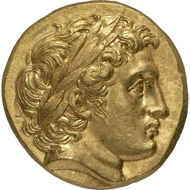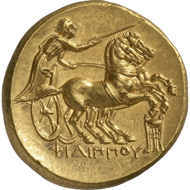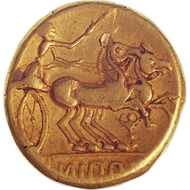By
With the kind permission of the MoneyMuseum, Zurich.
Why is it that for centuries – or rather thousands of years – the head has served as the motif for the side of a coin? And why has this changed in the last 200 years? Ursula Kampmann poses these questions in her book ‘MenschenGesichter,’ from which the texts for our new series are taken.
2
Alexander III, King of Macedonia (336-323 BC). Gold stater of the type introduced under his father, Philip II (359-336 BC), Colophon (Ionia), 324 BC. © MoneyMuseum.
Delphi, where the God Apollo proclaimed the will of the gods to the people, was one of the richest sanctuaries in Greece. Numerous cities had placed precious votive offerings there. It was this wealth that enticed the Phocians in the year 355 BC to capture the temple. Until then, a great number of cities, comprising the so-called Delphic Amphictyonic League, had decided the fate of the oracle. The amphictyony declared ‘holy war’ on the Phocians. But as the new rulers of Delphi had the seemingly unlimited resources of the temple treasury at their disposal, they were able to pay a sizable mercenary army that defeated against which their opponent’s forces were repeatedly felled. The turning point was only to come with the intervention of Philip II, King of Macedonia in the years 359 through 336 BC. He joined the battle on the side of the amphictyony and forced the Phocians to surrender in the year 346 BC.
Delphi wasn’t just fought over among the Greeks. Even the Gods fought over it. Heracles once stole the tripod, which Apollo had to reclaim, as can be seen on this black-figure Athenian oinochoe of the Taleides Painter. Around 520 BC. Source: Jastrow / Wikipedia.
The ambitious king naturally made the most of his victory. And not just by manning the strategically important Phocian fortresses with his own soldiers, and at the same time reserving a great number of votes in the council of the amphictyony, which increased his influence enormously. He also used his victory propagandistically. Hoards confirm that shortly after his victory, likely as early as the year 345 BC, Philip introduced a new type of coin that featured on its obverse the image of the patron of Delphi: Apollo. By 357 BC Philip had gained dominion over the Pangean mountains in Northern Greece, where abundant gold deposits were exploited. It was then time to take advantage of the profits from the mining, to use them to strengthen the Macedonian supporters in Greece and, of course, to recruit mercenaries. As for the obverse of the coin, Philip did not choose Zeus, who was considered a special tutelary deity of the Macedonians, or Heracles, the progenitor of the Argeads, whose house Philip belonged to. But rather he decided on Apollo, whose head proclaimed to all Greeks that Philip fought against the impious Phocians and that the gods had helped him and the just cause to victory.
Tribe of the Helvetii. Gold stater in the style of the stampings of Philip. Between 300 and 100 BC. © MoneyMuseum.
This type of coin became so popular throughout the entire ancient world that it continued to be minted even by Philip’s successor and son, Alexander the Great. That’s right – as a wage for Celtic mercenary soldiers, individual pieces made their way well into the heart of Europe where numerous Celtic stampings imitated Philip’s coins.
In the next chapter, you’ll learn more about the early Celtic coins, which were influenced by Greek prototypes.
All sections of the series can be found here.
The book “MenschenGesichter” is available in printed form from the Conzett Verlag website. It soon will be translated to English …










